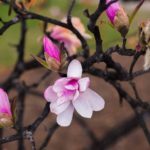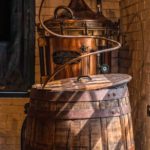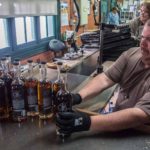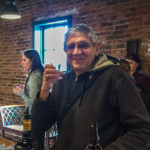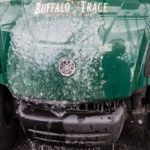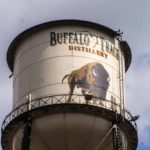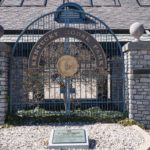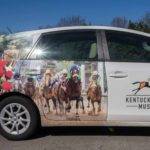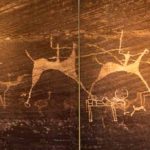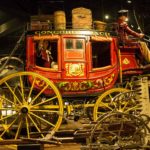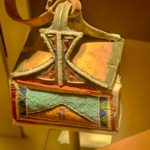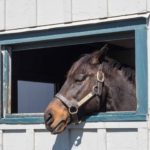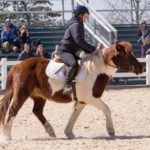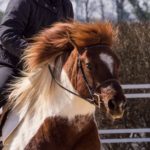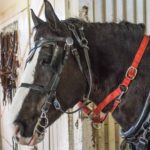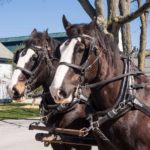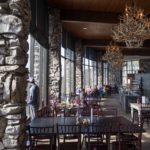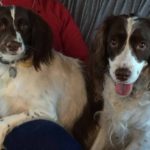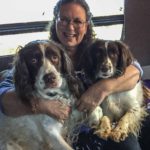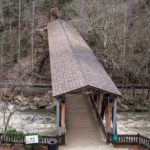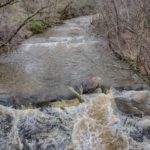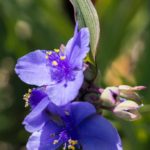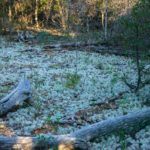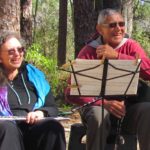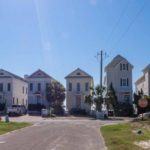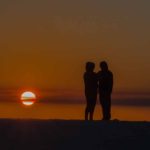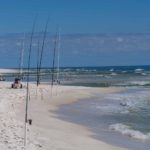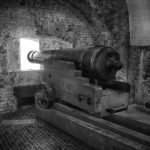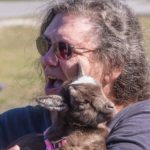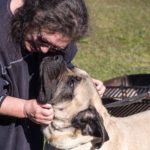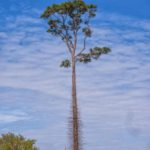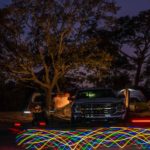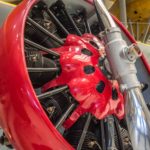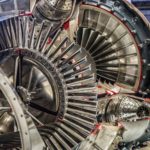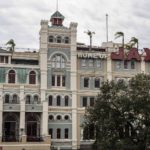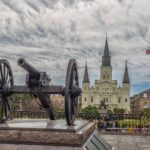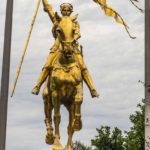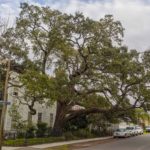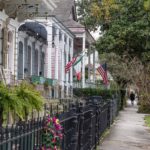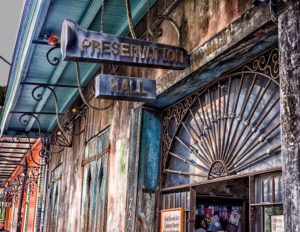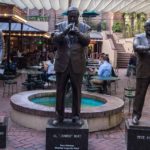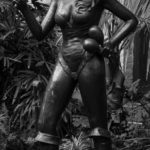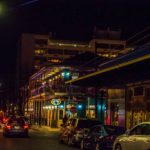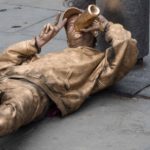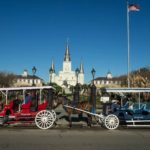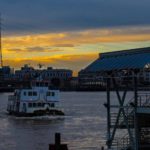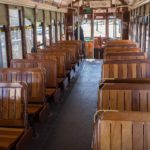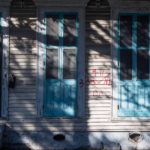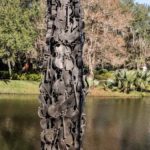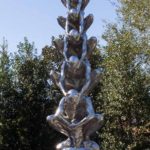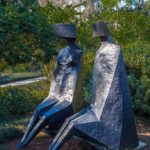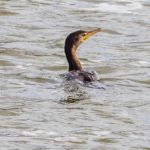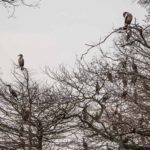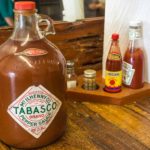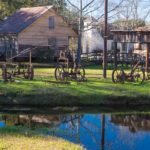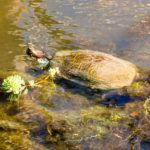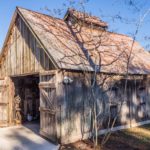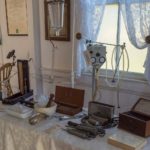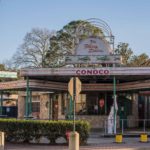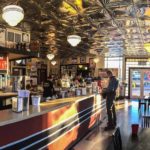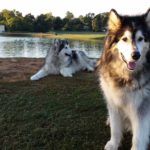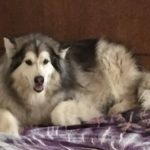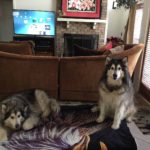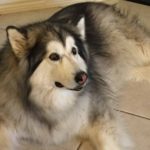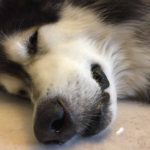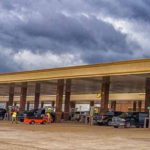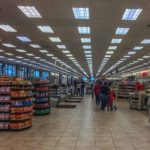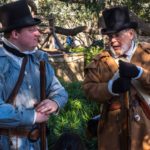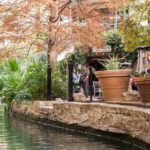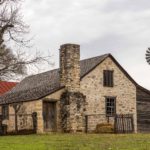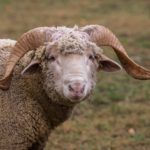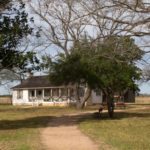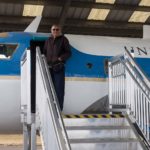

What else is one supposed to do in Kentucky if not sample some Kentucky bourbon and visit some of the worlds most famous thoroughbred horses? We did both.
The Buffalo Trace Bourbon Distillery
 Named after the area where buffalo used to cross the Kentucky river, the distillery is located West of Lexington Kentucky and has a reputation for producing some of the finest bourbon in the world. Bourbon is a type of whiskey made from corn and gets its unique taste from the charred oak barrels which hold the whiskey during the aging process. Given the 35 degree day and blustering winds, we were thinking about doing some ‘sipping’ before we embarked on the tour but that was not to be.
Named after the area where buffalo used to cross the Kentucky river, the distillery is located West of Lexington Kentucky and has a reputation for producing some of the finest bourbon in the world. Bourbon is a type of whiskey made from corn and gets its unique taste from the charred oak barrels which hold the whiskey during the aging process. Given the 35 degree day and blustering winds, we were thinking about doing some ‘sipping’ before we embarked on the tour but that was not to be. 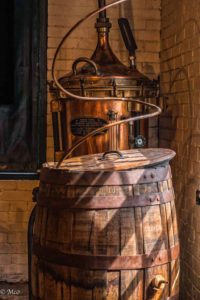 We learned about the history of the distillery, toured original factory buildings and saw the making of whiskey, aging in oak barrels, and packaging of the different ‘proof’ values. We observed employees working on a single barrel batch (most expensive) which was being hand bottled and packaged. At the end of the tour, shots of different bourbons were presented and we were able to belly up to the bar and have a taste. Cheryl went for a sweet blend of bourbon and cream (not a surprise), while Colin went for some samples of the genuine article.
We learned about the history of the distillery, toured original factory buildings and saw the making of whiskey, aging in oak barrels, and packaging of the different ‘proof’ values. We observed employees working on a single barrel batch (most expensive) which was being hand bottled and packaged. At the end of the tour, shots of different bourbons were presented and we were able to belly up to the bar and have a taste. Cheryl went for a sweet blend of bourbon and cream (not a surprise), while Colin went for some samples of the genuine article.
Click on any thumbnail below to see larger image gallery.
- Ingredients
- An Old ‘Still
- Hand Bottling a Single Barrel Batch
- Preparing for the Wax Seal
- Sealing
- Finished Product
- A little taste from our Tour Guide
- Cold day for touring
The Kentucky Horse Park
We stayed three nights at the campground adjacent to and owned by the Horse Park. The Horse Park itself covers an extensive area consisting of: stables and paddocks where famous horses and breeds are kept and exercised, a very comprehensive ‘Museum of the Horse’, and a number of show rings and arenas where some of the world’s most famous equine events are held. We found the Museum to be of the highest quality, tracing the history of the relationship between man and horse from cave paintings to modern day thoroughbred racing and breeding. We could have spent more time there. The park provides ‘retirement living space’ for some of the most famous thoroughbred racehorses in the US and we were able to get up close to them in the ‘Hall of Champions’ where we also heard about their individual successful racing careers.
We watched a display of different horse breeds at the ‘Breeding Barn’ and display ring where we had an opportunity to meet the different breeds and talk to their riders. We were able to watch a pair of magnificent Clydesdales being prepared for pulling a visitors’ trolly around the park, as well as learning about the role of horses in policing at the police horse barn. We loved getting to see and touch these beautiful animals. It was a thrill for both of us who were raised in non-agrarian circumstances: Los Angeles (Cheryl) and Whitley Bay (Colin).
Click on any thumbnail below to see larger image gallery.
- Horse Park Entry Gate
- Statuary everywhere
- Working Model
- Car Costume
- Cave painting
- Relief from Ancient Greece
- Man and Horse revealed
- Asian chariot
- Correction Shoes for different horses
- Array of transportation
- Indian Saddle
- Stirrup
- ‘Gin’ Kentucky Derby Winner
- ‘Da Hoss’ Breeders Cup Winner
- I hear ya!
- ‘Da Hoss’
- Chestnut Gelding
- Gypsy Vanner
- Gypsy Vanner
- Gypsy Vanner
- Gypsy Vanner
- Lipizzan
- Lipizzan
- Lipizzan
- Thoroughbred
- Thoroughbred
- Andalusian
- Andalusian
- Andalusian
- Great hair day
- Great tail
- Chincoteague Pony
- Chincoteague Pony
- Loved those ears
- Giving kisses
- Clydesdale being prepped
- Big hooves
- Clydesdale
- Clydesdales at work
Click on map below to see larger version
Kentucky Horse Park

 With our minds set on returning home a little earlier than planned (after hearing tales of an early Spring at home), we headed due North towards Huntsville, Alabama, stopping at two State Parks on the way. Chewacla SP looks like a mountain biker’s dream with many miles of bike trails through the woods, alongside the river, and a couple of ‘jump’ courses for the brave. Cheaha SP, further North, is situated on top of the Appalachian mountain range, the highest point in Alabama and gave us some wonderful views from the lodge, despite the weather.
With our minds set on returning home a little earlier than planned (after hearing tales of an early Spring at home), we headed due North towards Huntsville, Alabama, stopping at two State Parks on the way. Chewacla SP looks like a mountain biker’s dream with many miles of bike trails through the woods, alongside the river, and a couple of ‘jump’ courses for the brave. Cheaha SP, further North, is situated on top of the Appalachian mountain range, the highest point in Alabama and gave us some wonderful views from the lodge, despite the weather.
Huntsville, Alabama was a planned visit to a musician friend of Colin’s, ‘Chips’ and his wife Lynn Lanier.  Chips is a Northumbrian Smallpipes player like Colin and so we had a great time sharing stories, playing music, and even getting in Cheryl’s need for her fur fix with their two springer spaniels El and Gracie. Below the thumbnail image gallery is a music video with recordings of Chips, Cheryl, and Colin. Take a nice glass of wine or two before you hear them. We’ll sound a lot better. Thanks to Chips and Lynn for our comfortable 3 day layover filled with music and good times.
Chips is a Northumbrian Smallpipes player like Colin and so we had a great time sharing stories, playing music, and even getting in Cheryl’s need for her fur fix with their two springer spaniels El and Gracie. Below the thumbnail image gallery is a music video with recordings of Chips, Cheryl, and Colin. Take a nice glass of wine or two before you hear them. We’ll sound a lot better. Thanks to Chips and Lynn for our comfortable 3 day layover filled with music and good times.
 In Atlanta, Georgia, we visited Cheryl’s cousin Amy Gabel and her husband Tom Coyle. They were kind enough to show us much of Atlanta as well as feeding us delicious meals, as Tom is a gourmet cook. Amy and Cheryl spent most of the time reminiscing about their family memories – laughing and enjoying their time together. Thanks Amy and Tom for hosting us for 3 days! It was super!
In Atlanta, Georgia, we visited Cheryl’s cousin Amy Gabel and her husband Tom Coyle. They were kind enough to show us much of Atlanta as well as feeding us delicious meals, as Tom is a gourmet cook. Amy and Cheryl spent most of the time reminiscing about their family memories – laughing and enjoying their time together. Thanks Amy and Tom for hosting us for 3 days! It was super!
Click on any thumbnail below to see larger image gallery.
- Chewacla AL State Park
- Chewacla AL State Park
- Cheaha AL State Park
- Cheaha AL State Park
- Cheaha AL State Park
- Cheaha AL State Park
- Chips and Lynn
- Chips
- El and Gracie
- Fur fix accomplished
- Beautiful spot
- Amy Gabel and Tom Coyle
- Amy, always fun!
- Amy and Tom
- Covered Mill Bridge, Roswell, GA
Movie of Northumbrian Smallpipes and flute: Colin (solo); Colin & Cheryl; Chips, Colin & Cheryl
Click on map below to see larger version
Travel Through Alabama and Georgia

When I heard we could go to a wolf preserve in Chipley, FL on our way to Alabama, I lost my mind in excitement to take part in this adventure. The non-profit Seacrest Wolf Preserve‘s goal is to create greater awareness of this keystone species and the contributions they make to their natural eco-systems. Funny rules were stated on their website about what we could wear, what we could and couldn’t bring, and the fact that we were going to be sitting on the ground as wolves walked around us.
Finally the day arrived and we lined up to sign our liability waiver. Not long after that, we were escorted into the first of several compounds which were associated with different packs. We selected a log for a seat, and sure enough, it was a great pick for getting noticed by the wolves. The 6 trainers each had a bag of raw meat that they used to tempt the wolves in different directions, to walk among our group of 60 people. Not 10 minutes had passed and I was stroking the top of the wolf’s back, his soft underside, and giving a thorough scratch to his chest and head. I was rewarded with kisses (muzzle greetings) on my cheek and chin! Oh was I in heaven! Later when we were able to stand in front of several wolves to be photographed, Colin was also greeted with a full face-lick. It was already an astounding day and we were just getting started.
Lead by our tour guide, one of the more interesting things we did as a group, was being encouraged to howl. Within a few minutes, the different packs joined us, and then we were silent as they continued for several more minutes. To hear 34 wolves howling in a natural environment was surreal (hear the audio file below the photo gallery).
We visited two more compounds / different environments that included a stream and pond from which the wolves drank and swam and a deeply forested area where we saw a particular pack’s den.
In addition to the Gray, Arctic, and British Columbian wolves, there were peacocks, raccoons, fox, and skunk, which we could feed and stroke. No one got sprayed by the skunk, but a lot of people were too nervous to go near them!
Sleeping Near the Wolves
We had booked a campsite at the Wolf Preserve, and little did we know that we’d be the only campers and have a concert of wolf music during the night and morning light. When the howling began after all the other people had left the preserve, there we were, alone and hearing those musical voices, and getting such a kick out of being in their midst.
Strange Rules
We were not allowed to take our digital cameras or iPhones with us into the wolf enclosures; although disposable film cameras were allowed. Photography tours started at $650 for 1/2 day, so although disappointed that we were not able to get in on a VIP tour, our $25 pp entrance fee felt like a bargain of excellent value.
Full Disclosure
Our pictures of the wolves with our throw-away cameras were okay, but not up to Colin’s standard. Therefore, the banner you see above was created by me from pictures from the Seacrest website.
Click on any thumbnail below to see larger image gallery.
- Gray Wolves
- About to be kissed
- Saying Hello
- Brown Fox
- White Arctic Fox
- Pea Hens
- Peacock
Click to hear the Howling Wolves
Click on map below to see larger version
Seacrest Wolf Preserve, Florida

Thanks to our new-found friends Larry and Catherine Duchesne from Alberta, Canada, we planned a trip with them to Wakulla Springs State Park to see the Lodge and take a boat tour on the Wakulla River. The Springs are one of the largest and deepest freshwater springs in the world and provide an area for (human) swimming and diving in the Summer. The Lodge was built in 1937 and has a beautiful interior. We ate lunch there after our boat tour and a short walk on one of the nature trails. The tour down the river was excellent, our guide managed to find many interesting birds, along with some manatees, alligators, turtles and white-tailed deer. A Great Blue Heron was good enough to pose for us and allow some close up photographs as tour boat cruised by.
Later that day we visited St. Marks National Wildlife Refuge which covers 17,000 acres, stretching for 43 miles of coastland South of Tallahassee. The entrance near our campsite in Newport took us eventually to the mouth of the Wakulla River past many tidal ponds to St. Marks Lighthouse where we found several species of wading birds and ducks.
 One night Colin woke up as something slimy landed on his face. We found a tree frog, only about an inch long, which had managed to find its way into the van and immediately hopped into the back of the van when the lights came on. Then followed a search until, after emptying the rear of the van completely, we spotted him again hiding under our bed and released him back into the outdoors.
One night Colin woke up as something slimy landed on his face. We found a tree frog, only about an inch long, which had managed to find its way into the van and immediately hopped into the back of the van when the lights came on. Then followed a search until, after emptying the rear of the van completely, we spotted him again hiding under our bed and released him back into the outdoors.
 Finding our way around this part of Florida proved to be a little challenging as our GPS didn’t always match reality. However with three powered up and running we eventually found our destinations (see photo).
Finding our way around this part of Florida proved to be a little challenging as our GPS didn’t always match reality. However with three powered up and running we eventually found our destinations (see photo).
Click on any thumbnail below to see larger image gallery.
- Wakulla Springs Lodge
- Café (old Post Office)
- Lodge Exterior (1937)
- Ibis watched by white-tailed deer
- Wakulla River
- Turtle Race
- Cormorant
- Great Blue Heron
- Anhinga
- Little Blue Heron
- Anhinga
- Anhinga
- Gallinule
- St. Marks National Wildlife Refuge
- Juvenile Great Blue?
- Snowy Egret and Little Blue Heron
- Great Blue
- Grackles emitting some unusual mating calls
- Stowaway
- Lost in Florida?

 Our stay at Gulf Island National Seashore was limited to 14 days by National Park rules so we traveled East, exploring the Florida Panhandle. Beachfront parks are in short supply at this time of year so we stayed at Rocky Bayou State Park for a few days, next to a State Aquatic Preserve and appreciated the well-maintained campsite in the forest. We found some free days back on the Gulf Shore in St. Andrews State Park, near to Panama City. On the way, we visited Destin, on Santa Rosa Island and watched all the pre-season activity at the harbor, many boats being prepared for an influx of tourists looking to fish the Gulf.
Our stay at Gulf Island National Seashore was limited to 14 days by National Park rules so we traveled East, exploring the Florida Panhandle. Beachfront parks are in short supply at this time of year so we stayed at Rocky Bayou State Park for a few days, next to a State Aquatic Preserve and appreciated the well-maintained campsite in the forest. We found some free days back on the Gulf Shore in St. Andrews State Park, near to Panama City. On the way, we visited Destin, on Santa Rosa Island and watched all the pre-season activity at the harbor, many boats being prepared for an influx of tourists looking to fish the Gulf.
After a few more days on the beach, we headed further inland and East to Apalachicola National Forest where we found a picturesque campground next to Wright Lake. The campground was run by two wonderful lady ‘hosts’, Lora and Marleen, who kept the 16 campsites and surrounding area in an immaculate state.  They discovered we were traveling with our instruments, found another campground resident, Joesy Desjarlais, who played the guitar, and arranged and publicized two ‘Concerts by the Lake’ on Saturday and Sunday mornings. Our hosts even drove the 25 miles to the nearest town and came back to set up a ‘breakfast buffet’ for everyone who attended on both mornings. Our audience was very kind and appreciative, even outnumbered the musicians, and we met a couple from Vermont who were very familiar with the Annapolis area celtic music scene. We also met a couple Larry and Catherine from Edmonton, Canada, became instant friends, met fortuitously at our next stop and spent some time exploring together (see next post).
They discovered we were traveling with our instruments, found another campground resident, Joesy Desjarlais, who played the guitar, and arranged and publicized two ‘Concerts by the Lake’ on Saturday and Sunday mornings. Our hosts even drove the 25 miles to the nearest town and came back to set up a ‘breakfast buffet’ for everyone who attended on both mornings. Our audience was very kind and appreciative, even outnumbered the musicians, and we met a couple from Vermont who were very familiar with the Annapolis area celtic music scene. We also met a couple Larry and Catherine from Edmonton, Canada, became instant friends, met fortuitously at our next stop and spent some time exploring together (see next post).
 On our way to our next stop near Tallahassee, we visited Apalachicola, and toured St. George Island, another of the barrier islands on the Emerald Coast. On our travels along the barrier islands, we saw many beachfront properties with a unique narrow and tall style. Many homes were built on stilts. We thought it would be possible to ‘date’ the houses by the height of the stilts above sea level.
On our way to our next stop near Tallahassee, we visited Apalachicola, and toured St. George Island, another of the barrier islands on the Emerald Coast. On our travels along the barrier islands, we saw many beachfront properties with a unique narrow and tall style. Many homes were built on stilts. We thought it would be possible to ‘date’ the houses by the height of the stilts above sea level.
Click on any thumbnail below to see larger image gallery.
- Rocky Bayou State Park
- Lichen on the Forest Floor
- Palmetto Fan
- Destin Harbor
- Pelican Enjoying the Sun
- Catch of the Day
- St. Andrews Beach
- Red-breasted Mergansers
- Laughing Gull (immature)
- Fishing Lite
- Coots
- Ibis
- Wright Lake
- Narrow Bridge over the Swamp
- Mushroom
- Baby Gator
- Wright Lake Trail
- Palmetto Inspection
- Photos by C. Duchesne
- Audience of thousands
- Beachfront Property at St. George Island
Click on map below to see larger version
Florida Panhandle

 Florida’s ‘Emerald Coast’, so named because of the greenish sea color near to its white sandy beaches, is the South shore of Florida’s ‘Panhandle’. We picked the area for a lazy few weeks of warmer weather and sunshine while we waited for the weather further North to entice us homewards. It delivered as promised, without us having to travel further South and compete with US and Canadian ‘snowbirds’ for camping spots.
Florida’s ‘Emerald Coast’, so named because of the greenish sea color near to its white sandy beaches, is the South shore of Florida’s ‘Panhandle’. We picked the area for a lazy few weeks of warmer weather and sunshine while we waited for the weather further North to entice us homewards. It delivered as promised, without us having to travel further South and compete with US and Canadian ‘snowbirds’ for camping spots.  We stayed at Gulf Islands National Seashore near Pensacola and, in addition to time on the beach, explored next-door Fort Pickens, and visited the National Naval Air museum and Pensacola Lighthouse nearby. We also spent an evening at Pensacola’s ‘Short Attention Span Theatre’, where we saw five one-act plays. Colin appreciated being able to take a short nap and still enjoy the rest of the entertainment.
We stayed at Gulf Islands National Seashore near Pensacola and, in addition to time on the beach, explored next-door Fort Pickens, and visited the National Naval Air museum and Pensacola Lighthouse nearby. We also spent an evening at Pensacola’s ‘Short Attention Span Theatre’, where we saw five one-act plays. Colin appreciated being able to take a short nap and still enjoy the rest of the entertainment.
Life at the Beach
Our first day here was very windy so we were able to enjoy a lone kite surfer’s battle with the wind and waves. At the Fort Pickens Museum, we saw some displays showing the continuous movement of the Barrier Islands, particularly during hurricane season. Fort Pickens, built in 1834 on the edge of the narrow entrance into Pensacola Bay, is now about a mile from the channel. The fort was virtually indestructible when built and remained in Union hands throughout the Civil War.
Click on any thumbnail below to see larger image gallery.
- Wind Waves
- Sunset at the campground
- Heron leaving the sunk ship
- High Energy Fishing
- Kite Surfing
- Emerald Coast
- Fort Pickens
- Low Budget RV
- Baby Pigmy Goat
- Mastiff
- Still Dog Shopping
- Armadillo visiting the campsite
- Tree Hair
- Dawn Reeds
- Pensacola Lighthouse
- Spiral Staircase (171 steps)
- Fresnel Lens
- Lens Shadow
- Coastguard Pelican
- Campground after Sunset
- Bicycle Wheel LEDs
Birdlife
 Although early in the season, there was plenty of birdlife here including some pairs of Blue Herons and a pair of Ospreys building nests. We heard a story from a local bird photographer that the choice of a mate is sealed when the female accepts a twig from a male. There were plenty of twig deliveries here. Colin watched the pair of Ospreys for a while, noticing that the male would disappear.
Although early in the season, there was plenty of birdlife here including some pairs of Blue Herons and a pair of Ospreys building nests. We heard a story from a local bird photographer that the choice of a mate is sealed when the female accepts a twig from a male. There were plenty of twig deliveries here. Colin watched the pair of Ospreys for a while, noticing that the male would disappear.  After half an hour, the female’s calls became more and more persistent until the male returned with a twig for the nest. One time Colin noticed the female sounding persistent, almost angry at the non-appearance of her mate. When the male appeared 100 yards away on a branch, he temporarily ignored his mate, casually consuming a large fish. Sharing didn’t seem to be on his agenda. In addition to these predators, there were many small birds at our campsite. In particular, we enjoyed listening to the mocking birds and their endless variety of calls.
After half an hour, the female’s calls became more and more persistent until the male returned with a twig for the nest. One time Colin noticed the female sounding persistent, almost angry at the non-appearance of her mate. When the male appeared 100 yards away on a branch, he temporarily ignored his mate, casually consuming a large fish. Sharing didn’t seem to be on his agenda. In addition to these predators, there were many small birds at our campsite. In particular, we enjoyed listening to the mocking birds and their endless variety of calls.
Click on any thumbnail below to see larger image gallery.
- Sanderling
- Vireo
- Mocking Bird
- Vireo
- Red-Winged Blackbird
- Juvenile Laughing Gulls
- Pair of Blue Herons
- Twig transport
- Twig Inspection
- Osprey
- Twig Delivery
- Breakfast for One
Naval Air Museum
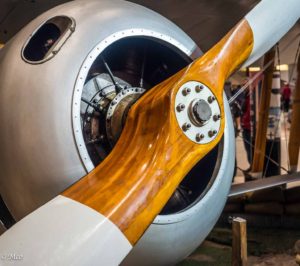 The Naval Air Station at Pensacola is the main Navy pilot training facility. It’s also the site of the National Naval Air Museum where we spent several hours. The exhibits and information there were top class, all the more impressive when we learned that restoration was almost exclusively carried out by volunteers. One of the most interesting exhibits included a WWII movie about training Navy pilots on Lake Michigan to land on aircraft carriers. Still today there are many aircraft at the bottom of the lake as a result of unsuccessful landings. Despite the extreme water temperature, trainee pilots were recovered by the effective rescue service so they could continue their training. We enjoyed seeing the evolution of the seaplane with the many exquisitely restored exhibits.
The Naval Air Station at Pensacola is the main Navy pilot training facility. It’s also the site of the National Naval Air Museum where we spent several hours. The exhibits and information there were top class, all the more impressive when we learned that restoration was almost exclusively carried out by volunteers. One of the most interesting exhibits included a WWII movie about training Navy pilots on Lake Michigan to land on aircraft carriers. Still today there are many aircraft at the bottom of the lake as a result of unsuccessful landings. Despite the extreme water temperature, trainee pilots were recovered by the effective rescue service so they could continue their training. We enjoyed seeing the evolution of the seaplane with the many exquisitely restored exhibits.
Click on any thumbnail below to see larger image gallery.
- Army and Coastguard Mascots
- German
- British
- Japanese
- ‘Tommy’ S-4C
- Note the wooden floats
- ‘Wildcat’
- Different view of the Blue Angels
- ‘Photo Banshee’ reconassaince
- New use for old aircraft seats
- Under Lake Michigan
- General Electric J33 Turbojet – 1947
- Rolls Royce J48 Turbojet – 1950
- Presidential Helicopter
Click on map below to see larger version
Gulf Breeze National Seashore, nr Pensacola, FL

The origins of this nickname for New Orleans are many and varied. We settled for it as being descriptive of the laid-back lifestyle in contrast to New York, “The Big Apple”. Founded by the French in 1718, handed to the Spanish in 1763, back to the French briefly in 1803 before becoming part of the US as part of the Louisiana Purchase. It became well known for the many music venues playing Jazz,, Blues, etc., and as a ‘party town’. During the period leading up to ‘Mardi Gras’ (Fat Tuesday), anything goes in the city, particularly in the famous French Quarter where the consumption of alcohol is allowed on the street. We arrived at the end of January, a week or two before the Mardi Gras celebrations were at their height and found an RV park a short walk from the edge of the French Quarter which was our base for 5 days exploring.
French Quarter Architecture
 The French Quarter is the oldest neighborhood in the city of New Orleans and was mainly constructed during the Spanish period during the late 18th century under the city’s Spanish rule. The extent of this style of architecture is unique, characterized by narrow streets, multistory buildings with liberal use of wrought ironwork, for the omnipresent balconies as well as fences, gates, door insets and downspouts. Much of the ironwork was added after the original construction, hence some of the French motifs in keeping with its heritage and name. We had fun exploring the Quarter, particularly the street musicians, Jackson Square and the Café Du Monde where we sampled the famous beignets (square fried donut – no hole – covered in powdered sugar).
The French Quarter is the oldest neighborhood in the city of New Orleans and was mainly constructed during the Spanish period during the late 18th century under the city’s Spanish rule. The extent of this style of architecture is unique, characterized by narrow streets, multistory buildings with liberal use of wrought ironwork, for the omnipresent balconies as well as fences, gates, door insets and downspouts. Much of the ironwork was added after the original construction, hence some of the French motifs in keeping with its heritage and name. We had fun exploring the Quarter, particularly the street musicians, Jackson Square and the Café Du Monde where we sampled the famous beignets (square fried donut – no hole – covered in powdered sugar).
Click on any thumbnail below to see larger image gallery.
- French Pharmacy Museum
- Silversmiths
- Pontalba Building
- House of Voodoo
- Voodoo too
- Ready for Mardi Gras
- St. Louis Cathedral
- Home of Jax beer
- St. Louis Cathedral
- Cathedral and Jackson Square
- Joan of Arc
- Famous Beignet Café
- Ancient Live Oakin Algiers
- Algiers District
- Algiers
- Algiers
- Algiers
Music and Night Life
The French Quarter and Frenchman Street had more than an abundance of music choices. It seemed every third building was a bar with live music. If you wanted to hear blues, early jazz, and contemporary bands, it was all here. The night life was just hopping! Even during the day, the music was pouring out of the buildings. Cheryl played jazz flute in her late teen years, and a visit to the famous Preservation Hall to listen to an accomplished ‘Traditional’ jazz band was a must. We couldn’t believe how small it was! The hall has acoustic concerts featuring some of the finest jazz performers which showcase the musical legacy dating back to the origins of jazz. We toured Frenchman Street just outside the French Quarter after dark, where some of the best music is to be found and enjoyed a more modern type of ‘Trad’ by the excellent ‘Smoking Time Jazz Club’ (sample below).
Click on any thumbnail below to see larger image gallery.
- Preservation Hall
- French Quarter
- Frenchman Street
- French Quarter
- Street Buskers
- Street Buskers
- Street Buskers
- Musical Legends Park
- Musical Legends Park
- Musical Legends Park
- Musical Legends Park
- Musical Legends Park
- Musical Events Calendar
- Unique Barman
- Frenchman Street
- Frenchman Street
- Zydeco
- Cheryl feeling blue
- Smoking Time Jazz Club
- Ladies Bathroom
- Frenchman Street Art Market
Characters
The French Quarter is filled with strange and wonderful people, in all shapes and sizes, and dressed amazingly unique. From a unicorn horn hat, pirates, and statue actors, they’re all great. Have to keep your sense of humor in this town.
Click on any thumbnail below to see larger image gallery.
Getting Around
 In addition to taxis and horse-drawn tours carriages, New Orleans has several electric streetcar routes which we used to visit areas outside the French Quarter. The St. Charles line still runs the (refurbished) original green streetcars. We loved the beautifully finished wooden seats and how they flipped to allow the streetcars to reverse their direction (unlike the famous San Francisco cable cars which use a turntable). We enjoyed looking around the “Creole Queen” paddle steamer and took a ferry ride across the Mississippi to the Algiers district. However, after dark, when it came to returning to our RV park after a hard day’s sightseeing, we took the advice of locals to go door to door and became avid ‘Uber’ users.
In addition to taxis and horse-drawn tours carriages, New Orleans has several electric streetcar routes which we used to visit areas outside the French Quarter. The St. Charles line still runs the (refurbished) original green streetcars. We loved the beautifully finished wooden seats and how they flipped to allow the streetcars to reverse their direction (unlike the famous San Francisco cable cars which use a turntable). We enjoyed looking around the “Creole Queen” paddle steamer and took a ferry ride across the Mississippi to the Algiers district. However, after dark, when it came to returning to our RV park after a hard day’s sightseeing, we took the advice of locals to go door to door and became avid ‘Uber’ users.
Click on any thumbnail below to see larger image gallery.
- DisneyWorld?
- Ferry to Algiers District
- Creole Queen
- Creole Queen
- Original Streetcar
- All wood-vintage streetcar
- N.O. Police Transport
Around the City
We took a city bus tour to visit some of the areas outside the French Quarter. We visited one of the many cemeteries in the city.  Graves are universally built above ground level to keep them out of the swamp, above the water table. This gives the cemeteries a characteristic Louisiana look and we spent a while comparing some of the old and modern designs, many of which are quite exotic and built to house multiple generations. We toured the devastated Hurricane Katrina area, where some of the houses are still marked with the numbers and codes left over from Katrina inspections. This was to make sure every house was inspected for missing people or animals left behind during the hurricane. The plaque at the site of the 14th Street Canal breach, which was responsible for most of the flooding in the city, correctly laid the blame for the breach on a design mistake now acknowledged by the Army Corps of Engineers. We were able to drive by ‘Villa Lobos’, the Pit Bull
Graves are universally built above ground level to keep them out of the swamp, above the water table. This gives the cemeteries a characteristic Louisiana look and we spent a while comparing some of the old and modern designs, many of which are quite exotic and built to house multiple generations. We toured the devastated Hurricane Katrina area, where some of the houses are still marked with the numbers and codes left over from Katrina inspections. This was to make sure every house was inspected for missing people or animals left behind during the hurricane. The plaque at the site of the 14th Street Canal breach, which was responsible for most of the flooding in the city, correctly laid the blame for the breach on a design mistake now acknowledged by the Army Corps of Engineers. We were able to drive by ‘Villa Lobos’, the Pit Bull  Rescue organization, which is also one of Cheryl’s favorite TV programs on HGTV. We passed the Marsalis Center for Musicians, created by Winton but organized in honor of his father. So many of the musicians here were left homeless after Katrina and this was a concerted effort to create new housing and center where the musicians could be supported. It is now used to encourage and support young musicians. City Park had some unusual outdoor sculptures and mostly fun. Colin thought of the of the upside-down man tied by his feet as an escape artist whereas Cheryl found it evocative of lynching in the South which provoked and saddened her.
Rescue organization, which is also one of Cheryl’s favorite TV programs on HGTV. We passed the Marsalis Center for Musicians, created by Winton but organized in honor of his father. So many of the musicians here were left homeless after Katrina and this was a concerted effort to create new housing and center where the musicians could be supported. It is now used to encourage and support young musicians. City Park had some unusual outdoor sculptures and mostly fun. Colin thought of the of the upside-down man tied by his feet as an escape artist whereas Cheryl found it evocative of lynching in the South which provoked and saddened her.
Click on any thumbnail below to see larger image gallery.
- This is the area/wall that failed
- Katrina Inspection codes still on some of the homes
- New Pumping Station
- Wall mural
- Villa Lobos Pit Bull Center
- Marsalis Center
- Provocative Art Installation
- Housing for the dead, all above ground
- Statue for the Unknown Confederate Soilders
Smoking Time Jazz Club Clip
Street Musicians in the French Quarter
Click on map below to see larger version
French Quarter, New Orleans

We were looking forward to spending time in South-West Louisiana for a number of reasons. Firstly, we have a liking for Cajun music and were interested in listening to and finding out more about Zydeco. Secondly, we both enjoyed reading the Detective Dave Robicheaux series of books about New Iberia by James Lee Burke. We were also fascinated by the history of the melting pot of ethnic groups, how they arrived and still keep their culture (including culinary) alive. We learned a lot about the history of how the French, Spanish, and British all played parts in its evolution to modern-day Louisiana. Our first major stop in Louisiana was New Iberia on the Bayou Teche. Our stay there was a good deal longer than planned, we both managed to catch sinus infections that put us out for over two weeks. Staying in one spot seemed like a good idea. Not to fret, we’re both “in the pink” again.
Bayou Teche Museum, New Iberia
The Bayou Teche Museum in downtown New Iberia gave us a good view of the history of the area and has a display of Robicheaux’s ‘Bait and Tackle Shop’; no sign of Batist, though. The artist, George Rodrigue’s early paintings consisted of images from his Louisiana and Cajun heritage. Just recently, Rodrigue allowed his paintings to be displayed and art studio to be reproduced for the museum.
Click on any thumbnail below to see larger image gallery.
- Dave Robicheaux’ ‘Bait and Tackle Shop’
- Zydeco History
- Spanish Arrival Mural
- Rodrigue’s Art Studio
- Dog Paintings by Cajun Artist Rodrigue
- Mardi Gras Art
Spanish Lake and Rip’s Rookery
Spanish Lake, West of New Iberia, is a large natural lake providing fishing and wildlife viewing. For $10 you can drive 5 miles around the lake and discover a barrier requiring a 10 point turn, 5 miles back to the entrance. I was taking an egret shot when the lady manning the entrance, stopped by me on her sunset clearout trip and said in true Cajun fashion, “You stay away from the water, you. They big snakes there.”
Rip’s rookery, a smaller lake also West of town, is a famous place for birdwatchers and many species use it as a resting place when migrating North or South. We arrived close to sunset and watched flocks of Snowy Egrets, Ibis (curved beak) and Anhingas arrive for overnight rest. The Egrets and Ibis seemed to be happy to intermingle, apart from a few territory squabbles. They were very noisy (see movie below). The Anhingas were content to occupy a space in the upper levels of the trees and watch the show. It was too cold for the Anhingas to put on the usual ‘wing drying’ display.
Click on any thumbnail below to see larger image gallery.
- Anhinga in Spanish Lake
- Snowy Egret
- Territory Squabble between Egrets and Ibis at Rip’s Rookery
- Anhingas
Crawfish and Boudin with Tabasco Sauce
 No-one can visit this area without sampling the local cuisine. We stopped for lunch in downtown New Iberia at Bon Creole, a great local café. The crawfish Po’ Boy sandwiches were a favorite of Colin’s. The size of the Tabasco Sauce bottle (made in New Iberia) was very impressive along with the murals. A few days later we sampled both Boudin (Cajun sausage) and boiled Crawfish at Crawfishtown USA, ‘Louisiana’s best Crawfish Restaurant’ in Breaux Bridge, East of Lafayette. Colin found the taste indistinguishable from Shrimp (and a bit harder to extract, despite a lesson from the waitress) but it was a fun experience, particularly when Cheryl went to work to help with the extraction.
No-one can visit this area without sampling the local cuisine. We stopped for lunch in downtown New Iberia at Bon Creole, a great local café. The crawfish Po’ Boy sandwiches were a favorite of Colin’s. The size of the Tabasco Sauce bottle (made in New Iberia) was very impressive along with the murals. A few days later we sampled both Boudin (Cajun sausage) and boiled Crawfish at Crawfishtown USA, ‘Louisiana’s best Crawfish Restaurant’ in Breaux Bridge, East of Lafayette. Colin found the taste indistinguishable from Shrimp (and a bit harder to extract, despite a lesson from the waitress) but it was a fun experience, particularly when Cheryl went to work to help with the extraction.
Crawfish are amazing creatures, living in ditches and lakes around the area. We found evidence of them, sometimes 100s of yards from visible water. They bury themselves into the ground making ‘chimneys’ with the earth they remove, until they reach the water table. This is not very far in most of Southern Louisiana which was described by a local as ‘a big swamp with a few sandbars where people live’.
We couldn’t leave New Iberia without taking a tour of the Tabasco Factory on Avery Island where peppers are grown, sauce is made and bottled and shipped all around the world. It was well worth the time, the self-guided tour was well organized and interesting. The business was started in 1868 and is still family-owned. The characteristic bottle size was chosen because of a supply of used cologne bottles available in the first few months of production. Colin noticed the plaque recording the fact that they are the sole supplier of Tabasco Sauce to the Queen of England (not surprising as they are the only makers of the sauce).
Click on any thumbnail below to see larger image gallery.
- Lunch at ‘Bon Creole’
- Man-size Tabasco Bottle
- Bon Creole Crawfish Mural
- Boiled Crawfish Lunch
- One of many Crawfish Chimneys at our Campground
- Tabasco Factory Store
- Bass Guitar owned by Michael Anthony (Van Halen)
- International Packaging
- Mixing and maturing
- Aging
- Lizzy’s Hot Sauce
Zydeco
 The highlight of our visit to South West Louisiana was the local music. Zydeco music is becoming very popular for dancing, particularly in this area. It is an Afro-Creole style, derived from the French Rhythm & Blues Influence, ‘La La’ music, with Cajun lyrics. Zydeco bands have at least one accordion player and a metal ‘rubbing vest’, like a washboard, known locally as a Zydeco Tie. It is often fast-paced with strong rhythms and inspires everyone to dance. There are many Zydeco bands now around the world but this area is where it all started.
The highlight of our visit to South West Louisiana was the local music. Zydeco music is becoming very popular for dancing, particularly in this area. It is an Afro-Creole style, derived from the French Rhythm & Blues Influence, ‘La La’ music, with Cajun lyrics. Zydeco bands have at least one accordion player and a metal ‘rubbing vest’, like a washboard, known locally as a Zydeco Tie. It is often fast-paced with strong rhythms and inspires everyone to dance. There are many Zydeco bands now around the world but this area is where it all started.
 Some friends advised us to go to the ‘Café Des Amis’ in Breaux Bridge for their Saturday Zydeco Breakfast. It turned out the restaurant was closed but ‘Buck and Johnny’s’ up the street had taken over the tradition. It’s quite a sight to see and hear the enthusiastic dancers at 8 a.m. on a Saturday morning! As in many places we visited in Louisiana, we soon were talking to the friendly people who explained all about the local traditions and culture and gave us pointers on other places to visit. They even attempted to teach both of us some of the dance steps.
Some friends advised us to go to the ‘Café Des Amis’ in Breaux Bridge for their Saturday Zydeco Breakfast. It turned out the restaurant was closed but ‘Buck and Johnny’s’ up the street had taken over the tradition. It’s quite a sight to see and hear the enthusiastic dancers at 8 a.m. on a Saturday morning! As in many places we visited in Louisiana, we soon were talking to the friendly people who explained all about the local traditions and culture and gave us pointers on other places to visit. They even attempted to teach both of us some of the dance steps.
 Another local tip took us to ‘the best Zydeco spot in Louisiana, Whiskey River’, a bar and Sunday Night dance out in the country overlooking the Atchafalaya Basin, next to a Levee. By the time we found it, it was getting dark and the car park was full and overflowing into a hilly grassed area. Overly confident in our van’s ability, Colin made a run at the hill into the overflow parking. We made it almost to the top but hadn’t allowed for the soggy ground and ended up with wheels spinning and the van settling in to the mud. After a good deal of rocking back and forth and plenty of advice from locals who were either blocked in or blocked out, we managed to get the van rolling backwards down the hill out of trouble. We managed to find a spot along the road and walked back towards the music. We had fun, enjoying the music, talking to locals and taking in the mix of cultures, all dancing together having a good time. (Colin still has nightmares of hundreds of angry drunk dancers trying to get out of the parking lot at closing time).
Another local tip took us to ‘the best Zydeco spot in Louisiana, Whiskey River’, a bar and Sunday Night dance out in the country overlooking the Atchafalaya Basin, next to a Levee. By the time we found it, it was getting dark and the car park was full and overflowing into a hilly grassed area. Overly confident in our van’s ability, Colin made a run at the hill into the overflow parking. We made it almost to the top but hadn’t allowed for the soggy ground and ended up with wheels spinning and the van settling in to the mud. After a good deal of rocking back and forth and plenty of advice from locals who were either blocked in or blocked out, we managed to get the van rolling backwards down the hill out of trouble. We managed to find a spot along the road and walked back towards the music. We had fun, enjoying the music, talking to locals and taking in the mix of cultures, all dancing together having a good time. (Colin still has nightmares of hundreds of angry drunk dancers trying to get out of the parking lot at closing time).
Click on any thumbnail below to see larger image gallery.
- Zydeco Brunch
- Lunch at Landry’s
- Dancers at Whiskey River
- Geno Delafose & French Rockin’ Boogie
- Raccoon in the Whiskey River Bar
- Preparations for Mardi Gras, Breaux Bridge
- Sunrise at our RV Resort
Acadian Village
 The term ‘Cajun’ is a derivation from ‘Acadian’. Acadia is an area in the Canadian Maritime Provinces (Nova Scotia, New Brunswick, Prince Edward Island) which was fought over by the British and French. The war was settled by the 1713 Treaty of Utrecht but when many of the local French-speaking people refused to sign an oath of allegiance to Britain, participated in the ongoing hostilities and were concerned about religious freedom to continue practicing their Roman Catholic religion. This led to The Expulsion of the Acadians during 1755-1764. After deportation, many of them migrated to Louisiana and became the ancestors of today’s Cajun people.
The term ‘Cajun’ is a derivation from ‘Acadian’. Acadia is an area in the Canadian Maritime Provinces (Nova Scotia, New Brunswick, Prince Edward Island) which was fought over by the British and French. The war was settled by the 1713 Treaty of Utrecht but when many of the local French-speaking people refused to sign an oath of allegiance to Britain, participated in the ongoing hostilities and were concerned about religious freedom to continue practicing their Roman Catholic religion. This led to The Expulsion of the Acadians during 1755-1764. After deportation, many of them migrated to Louisiana and became the ancestors of today’s Cajun people.
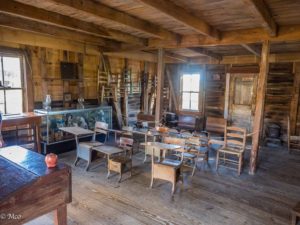 North of Lafayette, is ‘Acadian Village’ the oldest reconstruction of a typical Acadian settlement. It was built with local labor and is a showcase of historic homes alongside winding bayous depicting Acadian immigrant life. It has been very beautifully and faithfully constructed and is also now a fund-raising source for LARC (Lafayette Association for Retarded Citizens), its beneficiaries living nearby in a group home. We spent a pleasant afternoon touring the village and reading about Acadian life in the 1800s.
North of Lafayette, is ‘Acadian Village’ the oldest reconstruction of a typical Acadian settlement. It was built with local labor and is a showcase of historic homes alongside winding bayous depicting Acadian immigrant life. It has been very beautifully and faithfully constructed and is also now a fund-raising source for LARC (Lafayette Association for Retarded Citizens), its beneficiaries living nearby in a group home. We spent a pleasant afternoon touring the village and reading about Acadian life in the 1800s.
Click on any thumbnail below to see larger image gallery.
- Magnolia bloom
- Re-purposed Conoco Station, now restaurant
- Borden’s Ice Cream Parlor
- Ice cream is sure to wake up this little beauty
4 Movies: Zydeco Brunch (1.09 min); Zydeco at Whiskey River (43 sec); Catfish (13 sec); Birds at Rip’s Rookery (59 sec)
Map Text
Click on map below to see larger version
Cajun Country, Louisiana

We headed north toward Dallas, Texas to visit my niece Sami and her husband John in the small town of Grapevine. Sami and John were married this past March in a private ceremony conducted by Sami’s cousin, Rabbi K’vod Wieder. The newlyweds recently moved from La Jolla, CA because of a job opportunity for Sami. We were able to spend the last two nights of Chanukah with them and New Year’s. Sami, John, and their two giant Malamutes, Merlin and Mya seem to be making a lovely home for themselves. Anytime the temperature rises above 70, on goes the air conditioning. This is to keep the pups happy because their winter fur coats make them hot and then it’s hard for them to breathe. So the four humans survived by wearing hoodies and visiting while under thick blankets. My family loved hearing that we were going to stay a few days parked in front of Sami and John’s home, but teased me that they really knew my motives: to be with the dogs. Well, getting my fur fix was deeply satisfied by the 4 days we spent there, but the human contact was truly more important and lovely. I love you Sami and John!
Meet Merlin and Mya
If you’ve had enough of dog photos, move along and read something else on the blog, because mostly, these are pictures of Merlin and Mya. Sami is a very private person and doesn’t want her picture on the Internet so I’ve purposefully left her out of the photos. John, on the other hand, is on Facebook, Instagram, and is my ‘friend’, and posts often, as long as he doesn’t include his lovely bride. Enjoy these delightful gentle giants. Note: Some of the photos came from Sami and John, not all are mine or Colin’s.
All captions are descriptions from left to right.
Click on any thumbnail below to see larger image gallery.
- Mexican dinner
- Chanukah/New Year’s
- A surprise breakfast for us by Sami
- Mya, John, Merlin
- Mya, Merlin, Grapevine Lake
- As pups
- Mya and Merlin
- Back in La Jolla
- We’re watching a movie, all of us on the couch!
- Merlin
- Dinner with broccoli
Map Text
Click on map below to see larger version
Grapevine, Texas

When people speak about Texas Big Country, it’s not an understatement. The filling station (below) and attached store blew our minds. It was just so Big! We couldn’t imagine how these stalls would be filled up, but they were.
About Lindon Baines Johnson (LBJ)
Since the 60s, I wanted to see and understand the man who brought us so much social  change but also had the Vietnam War as a legacy. The war seems to have overwhelmed all the great things LBJ did, all the changes he enacted, all the good services offered for the poor. There is no doubt he felt at a loss to solve the Vietnam problem. There are so many of us that cannot forget how deadly the war was, how inhumane, and the pall of ‘baby killers’ on people’s lips. It wasn’t the military’s fault to be sent in, but so many of my baby-boomer hippy friends pointed the rhetoric at anyone within spitting distance. It was indeed a sad time.
change but also had the Vietnam War as a legacy. The war seems to have overwhelmed all the great things LBJ did, all the changes he enacted, all the good services offered for the poor. There is no doubt he felt at a loss to solve the Vietnam problem. There are so many of us that cannot forget how deadly the war was, how inhumane, and the pall of ‘baby killers’ on people’s lips. It wasn’t the military’s fault to be sent in, but so many of my baby-boomer hippy friends pointed the rhetoric at anyone within spitting distance. It was indeed a sad time.
The bills Johnson helped pass were cornerstones for the lower and middle classes, to give them a hand up out of poverty. Johnson put through and Congress passed 1000 new bills. This is how NPR, PBS, Head Start, Equal Housing amendments, Medicare, Medicaid, Elementary and Secondary Education Act, 1964 Civil Rights Act, Voting Rights Act, the Product Safety Commission, and so many more significant bills were created, which became an important part of our society.
 We visited San Antonio, Austin and Fredericksburg, stopping on the way at Johnson City, the birthplace and home of LBJ, the cemetery where he and Ladybird are buried, and the LBJ Ranch. So much history and from such humble beginnings.
We visited San Antonio, Austin and Fredericksburg, stopping on the way at Johnson City, the birthplace and home of LBJ, the cemetery where he and Ladybird are buried, and the LBJ Ranch. So much history and from such humble beginnings.
LBJ started his career as a school teacher, in a one-room school, to Hispanic children. When he saw the poverty and lack of meals, supplies, clothing, it made an impression on him that never faded. When he became a Senator, he used his power to change Texas for the better. When he became the President, he used his gift of negotiation to the fullest. He came to power after John F. Kennedy was assassinated in 1963 and served as President until 1969.
San Antonio
I wanted to visit the Alamo where The ‘King of the Wild Frontier’, Davy Crockett, lost his life.  So much has been written about the Alamo, history of this mission turned fort and the defeat of the small group of Texan defenders by overwhelming Mexican forces lead by ‘Santa Ana’. It was very interesting to learn some of the detailed history behind the border wars, how Texas started out as a Republic and eventually became one of our States. Some of the original buildings stand, but most walls have been reconstructed from original plans. The courtyards, horse stalls, military dorms, and supply rooms were cool in the hot sun, the walls being 2 feet thick. After visiting the Alamo, we took a boat tour to see San Antonio’s famous ‘Riverwalk’ district, an extensive waterway development with many shops, restaurants and other attractions.
So much has been written about the Alamo, history of this mission turned fort and the defeat of the small group of Texan defenders by overwhelming Mexican forces lead by ‘Santa Ana’. It was very interesting to learn some of the detailed history behind the border wars, how Texas started out as a Republic and eventually became one of our States. Some of the original buildings stand, but most walls have been reconstructed from original plans. The courtyards, horse stalls, military dorms, and supply rooms were cool in the hot sun, the walls being 2 feet thick. After visiting the Alamo, we took a boat tour to see San Antonio’s famous ‘Riverwalk’ district, an extensive waterway development with many shops, restaurants and other attractions.
Austin
First priority in Austin was to visit the LBJ Library on the University of Texas Campus. There we found tapes, archives, photographs, and history written in a very easy to understand way. Lots of children visited the library on the day we toured and giggled their way through Johnson’s colorful language.
I think the story I most liked about LBJ is how he got his agenda passed through Congress. He found out what a Senator wanted for the district, and then he’d use that carrot to get what he wanted to accomplish.
In the evening, we walked the music district, visited some bars with
live music. The next day, we drove to Fredericksburg, stopping at the JBJ Ranch and homestead. This is a combined State and Federal area. The tour took us first to a small 1900’s working farm where costumed interpreters carry out day-to-day activities; the dairy, meat and vegetables are raised there. We visited the little one-room building where Johnson started his education at the age of 4. Next, was LBJ’s working Ranch with its herds of Hereford cattle and sheep in addition to a herd of Bison and one of Texas Longhorns. While in office, Johnson spent a large percentage of his time at the Ranch. He equipped the ranch with all the communications and security facilities required and held many meetings there, some with foreign Heads of State. He felt at an advantage, when offering the hospitality of the ranch, which he felt helped his negotiating position. He loved to conduct meetings under the big oak tree outside his home, but also spent time with international leaders discussing policy around his pool. The ranch had to be reorganized and remodeled to handle the FBI detail, the staff, along with the Air Force plane (dubbed “Air Force 0.5”) that ferried him from Washington, DC and back to the small airstrip next to the ranch. The Johnson cemetery is in this area along with the gravestones for Ladybird and LBJ, and his relatives.
Click on any thumbnail below to see larger image gallery.
- Austin restaurant, carved dinette from Mexico
- Texas Big: Buc-ee’s Gas Pumps
- Buc-ee’s: a 7-11 type store on steroids
- Texas Big: Drink dispenser
- Texas Big: Beef Jerky display
- Buc-ee’s purse display
- San Antonio
- The Alamo, San Antonio
- Original Alamo
- Reenacting 1860s
- Davy Crockett, my childhood hero. Died: 1836 at the Alamo.
- Riverwalk, San Antonio
- Boat ride near Riverwalk, San Antonio
- Fun Ads
- River Walk, San Antonio
- Riverwalk
- Austin
- Just like Colin’s humor
- Unusual signage
- LJB Library Hall, Austin
- OK, Mr. President, whatever you want.
- LBJ Park
- Ten-year old’s listening to President Johnson
- 1800s working ranch
- Working 1800s ranch
- Heat source
- Everything they ate, they grew
- Pretty bird
- Pretty bird
- Pretty leggings
- Tac room
- Sheep
- Long horn steer
- Bison on the property
- LBJ’s birthplace
- LBJ Homestead
- LBJ Ranch: This is where LBJ held meetings, under this oak
- Two larger headstones: Ladybird & LBJ
- LBJ
- Airforce .5
- LBJ Ranch had its own firehouse
Map Text
Click on map below to see larger version
LBJ Country, Texas


